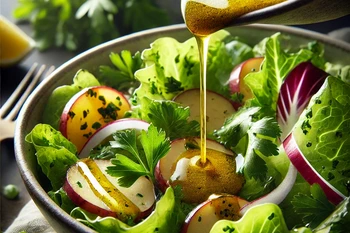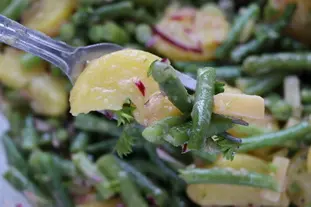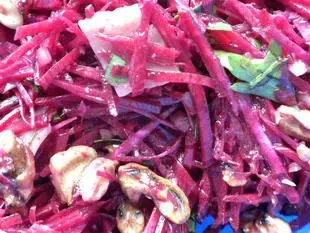Sauce and salad: When and how to mix them?

When dressing a salad, there's a kind of golden rule: add the dressing very shortly before serving, especially if your salad contains crunchy elements such as croutons or fresh vegetables, which will retain their crunchiness or crispiness.
But, as is often the case in the kitchen, there are exceptions, and in some cases, anticipating the addition of the dressing can sublimate the texture and flavours of your salad.
Let's take a look at these exceptions.
But, as is often the case in the kitchen, there are exceptions, and in some cases, anticipating the addition of the dressing can sublimate the texture and flavours of your salad.
Let's take a look at these exceptions.
7,422 5/5 (2 reviews)
Keywords for this post:SauceSaladTimingMixCrunchyFondantLast modified on: November 29th 2024
Sauce and salad: When and how to mix them?
Why add dressing at the last minute?
In general, dressing or sauce tends to soften salad leaves or crunchy bits.By mixing them in too early, you risk losing the freshness and texture that make a salad so enjoyable to eat.
Croutons soften, vegetables become a little limp, in short, it's not great.
To avoid this, prepare your dressing in advance, but mix it into the salad just before serving.
This ensures that each ingredient retains its original texture, while being delicately coated with flavor.
Do I always have to do this?
No. On the contrary, for some salads, it's a good idea to season a little in advance.Here are two cases where you can (and perhaps should) mix the dressing a little earlier:
- Salads with potatoes: Potatoes, especially when still warm, absorb dressing very well, whether it's a light vinaigrette or a fragrant mayonnaise.
By mixing them ahead of time, they become more melt-in-the-mouth and infused with flavor. This transforms a simple potato salad into a real delight.
- Salads with firm vegetables: Some vegetables, like red cabbage or raw beet for example, have a firm texture that early seasoning helps to tenderize slightly, making the salad more pleasant to chew while developing the flavors.

How to find the right balance?
Here are a few tips on when and how to mix your dressing:- For delicate salads: Salad greens, lamb's lettuce or arugula should be seasoned at the very last moment to preserve their freshness.
- For mixed salads: If your salad contains croutons or dried fruit, add them after the dressing to keep them crunchy.
- For firm vegetable or potato salads: Mix the dressing at least 30 minutes before serving, to allow the flavors to soak in and the textures to soften.
Follow the general rule to preserve crunch, but don't hesitate to get ahead of the game with potatoes or firm vegetables to enhance their flavor and tenderness.
To sum up: every salad has its own specificities. Test, adjust and find the perfect moment to season your own.
Lasts posts
Butter vs. grease
We often read in a recipe where a pastry is put into a mould that, just before pouring, the mould should be buttered or greased. But what's the difference between these 2 terms?December 1st 20251,2865
Getting out of the fridge early
Very often when you're cooking, you need to take food or preparations out of the fridge, to use them in the recipe in progress. There's nothing tricky about this: you just take them out of the fridge and use them, usually immediately, in the recipe. But is this really a good method?November 24th 20251,2395
Who's making the croissants?
When you look at a bakery from the outside, you naturally think that in the bakery, the bakers make the bread, and in the laboratory, the pastry chefs make the cakes. It's very often like that, with each of these professions having quite different ways of working, but sometimes there's also one...November 23th 20251,125
Oven height
When we put a dish or cake in the oven, we naturally tend to put it on the middle shelf, and that's what we usually do. But in some cases, this position and height can be a little tricky, so let's find out why.October 8th 20253,0895
The importance of sieving
In recipes that use a fine powder (flour, powdered sugar, etc.), you'll often see the advice to sift before using it. To sift is to pass the powder in question through a sieve (a very fine strainer) before incorporating it into your recipe. It's often advice, but is it really useful?September 3rd 20257,7683
Other pages you may also like
Candied fruits: don't get ripped off
Do you like candied fruit? You might like to nibble a handful or add it to a recipe, like a classic fruit cake or delicious Italian specialities like panettone or sicilian epiphany pie.June 21th 201767 K 24.2
A few tips for effective kneading at home
When you have to knead dough for bread or some other recipe, you may well use a food processor or the type of machine known as a stand mixer. The best-known brands are Kenwood and KitchenAid. They are useful tools, but here are a few tips to help you get the best out of them.June 23th 2021284 K 23.8
Different kinds of pastry and dough
When cooking in general, and particularly in baking, we can make and use many different kinds of pastry and dough. All built on the same "base": flour - a powder to which we add fat, liquid or both to produce the dough which is then cooked. .November 6th 2012111 K 14.0
The window-pane test in bread-making
The home bread-makers often ask themselves “Have I kneaded my dough long enough?” . A good question, as dough that is insufficiently kneaded will not rise properly or will fall flat when the top is slashed, which is very frustrating. To know when the dough is ready, one can rely on the length...June 16th 202197 K 23.9
Sausage broth
I've already talked to you about vegetable cooking water, which becomes a precious broth after cooking that would be a shame to throw away. Now let's look at the special case of meat cooking broth, and in particular sausages, which are often poached.June 28th 202312 K5
Post a comment or question
Follow this page
If you are interested in this page, you can "follow" it, by entering your email address here. You will then receive a notification immediately each time the page is modified or a new comment is added. Please note that you will need to confirm this following.
Note: We'll never share your e-mail address with anyone else.
Alternatively: you can subscribe to the mailing list of cooling-ez.com , you will receive a e-mail for each new recipe published on the site.









